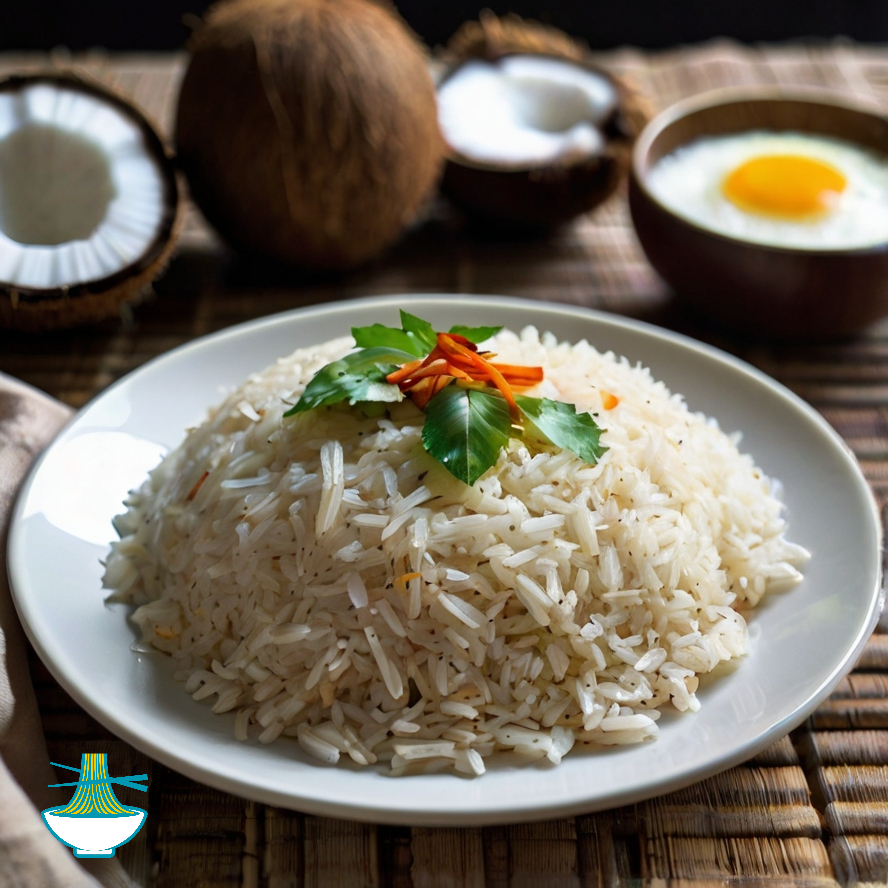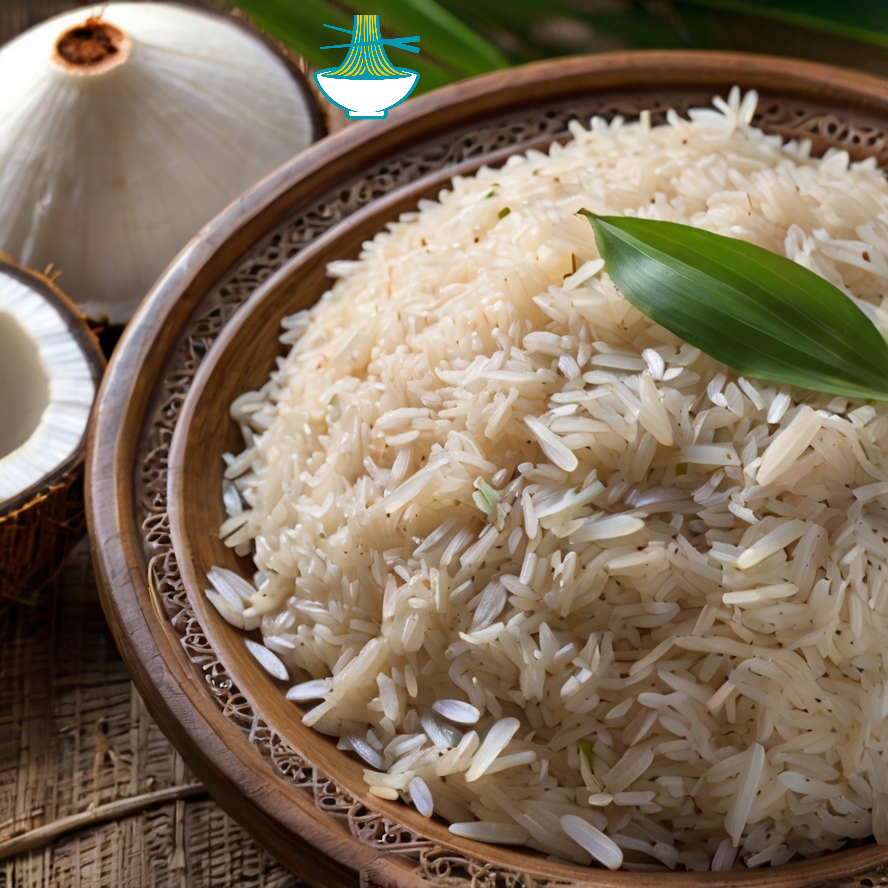Coconut Milk Rice is a delightful dish that combines the simplicity of rice with the rich, creamy goodness of coconut milk. Packed with essential vitamins like vitamin B6, niacin, and pantothenic acid, this dish also provides healthy fats that support heart and brain health. However, due to its fat content, moderation is key to enjoying its benefits without overindulgence. This comforting dish is not only a great source of energy but also aids in digestion and provides a natural boost to the immune system, thanks to the antibacterial properties of coconut milk.
Ingredients:
- 2 cups of long-grain rice (e.g., jasmine or basmati)
- 1 ½ cups coconut milk
- 1 ½ cups water
- 1 teaspoon salt
- 1 tablespoon vegetable oil or butter (optional)
- Fresh herbs for garnish (optional)
Ingredient Substitutes:
In case some ingredients are unavailable or if you're looking for healthier alternatives, here are a few options:
- Vegetable Oil Substitute: If you're looking for a plant-based fat alternative, use coconut oil or olive oil instead of vegetable oil to maintain a coconut flavor or add heart-healthy fats.
- Butter Substitute: For a dairy-free option, you can substitute butter with vegan butter or use an extra tablespoon of coconut oil to maintain the richness of the dish.
- Low-Fat Coconut Milk: If you want a lighter version of the dish, opt for low-fat coconut milk to reduce the calorie and fat content while still preserving the coconut flavor.
Instructions:
- Rinse the Rice: Start by rinsing the long-grain rice under cold water. This step is important to remove excess starch and prevent the rice from becoming sticky. Continue rinsing until the water runs clear, ensuring the rice is fully cleaned before cooking.
- Prepare the Cooking Liquid: In a large pot, combine coconut milk, water, salt, and oil (if using). Stir well to ensure the salt is evenly distributed. If you prefer a richer flavor, you can use coconut oil or butter instead of vegetable oil. Bring the mixture to a gentle boil over medium-high heat, allowing the coconut milk to fully combine with the water and salt.
- Add the Rice: Once the coconut milk mixture is boiling, carefully add the rinsed rice into the pot. Stir gently to ensure the rice is evenly spread in the liquid. Reduce the heat to low and cover the pot with a tight-fitting lid to trap the steam and ensure the rice cooks evenly.
- Simmer the Rice: Let the rice simmer for about 15-20 minutes, or until the liquid is absorbed and the rice is tender. Avoid lifting the lid during this time to keep the steam inside, which is crucial for properly cooking the rice. The rice should be soft and fully cooked, with no remaining liquid in the pot.
- Let It Sit: After the rice has finished cooking, remove the pot from the heat. Let the rice sit, still covered, for an additional 5 minutes. This step allows the rice to firm up slightly and ensures the grains are fully separated.
- Fluff the Rice: After the resting period, remove the lid and use a fork to fluff the rice gently. This helps to separate the grains and enhances the texture.
- Garnish and Serve: Optionally, garnish the rice with fresh herbs like cilantro, mint, or parsley for an extra burst of flavor and color. Serve the coconut milk rice warm as a side dish to accompany curries, grilled meats, or vegetables. Alternatively, enjoy it as a standalone meal for a light yet satisfying option.
New Serving Ideas:
To make the dish more versatile, consider pairing coconut milk rice with the following options:
- Vegetarian Dishes: Serve it alongside grilled vegetables like zucchini, bell peppers, or eggplant for a light and flavorful meal.
- Meat or Seafood: It pairs wonderfully with dishes like grilled chicken, shrimp, or lamb. The creaminess of the rice complements the richness of these proteins.
- Curries and Stews: Coconut milk rice works well with spicy Indian curries, Thai curries, or vegetable stews, balancing out the heat and adding a creamy texture.
Flavor Enhancements:
While coconut milk rice is delicious on its own, there are several ways to enhance the flavor and make it even more nutritious:
- Spices: Add cinnamon, cardamom, or cumin for a warm, aromatic flavor. You could also experiment with a pinch of turmeric for a golden color and earthy taste.
- Nuts: Consider sprinkling toasted almonds, cashews, or pistachios on top for added texture and a boost of healthy fats.
- Dried Fruits: Incorporate dried fruits like raisins, cranberries, or apricots for sweetness and a delightful contrast to the creaminess of the coconut milk.
These additions can not only improve the flavor but also increase the nutritional profile by adding vitamins, minerals, and fiber.
Precautions:
- Coconut milk is generally safe for most people, but there are a few precautions to consider. Those with coconut allergies should avoid this dish. Additionally, people who are watching their weight or have high cholesterol levels should consume coconut milk in moderation, as it is high in saturated fat. The medium-chain triglycerides (MCTs) found in coconut milk are healthy fats, but they still contribute to overall caloric intake. It’s important to be mindful of portion sizes, especially for individuals managing these conditions.
Frequently Asked Questions (FAQs)
Can I use other types of rice?
- Yes, you can use other types of rice, such as basmati, jasmine, or even brown rice if you prefer. However, note that cooking times may vary, especially with brown rice, which may require additional water and cooking time.
Can I use low-fat coconut milk?
- Yes, you can substitute regular coconut milk with low-fat coconut milk to reduce the fat content. This will make the dish lighter while still maintaining the coconut flavor.
Is this dish suitable for people on specific diets?
- Coconut milk rice can be suitable for people following a gluten-free or keto diet, as it is naturally gluten-free. However, individuals on low-fat diets should consume it in moderation due to the fat content in coconut milk.
How should I store leftover coconut milk rice?
- Leftovers can be stored in the refrigerator for 2-3 days. For best results, reheat it on the stove with a splash of water or coconut milk to restore its creamy texture. It can also be frozen for longer storage.
Can I add other vegetables or ingredients to boost the nutritional value?
- Absolutely! You can add vegetables like carrots, peas, or spinach to enhance the nutritional value. For extra protein, you can also add chickpeas or tofu for a plant-based option. These additions will provide more fiber, vitamins, and minerals.

Nutritional Values and Benefits
1. Long-Grain Rice (2 cups)
- Calories: 408
- Carbohydrates: 89g
- Protein: 8g
- Fat: 0.7g
- Vitamins:Vitamin B6: 0.3mg (25% DV)
- Niacin: 3.4mg (22% DV)
Nutritional Benefit: Rice provides a quick energy boost and is easy to digest. It is gluten-free, making it suitable for individuals with gluten intolerance.
2. Coconut Milk (1 ½ cups)
- Calories: 552
- Carbohydrates: 6g
- Protein: 5g
- Fat: 57g
- Vitamins:Vitamin C: 2mg (3% DV)
- Iron: 3.9mg (22% DV)
Nutritional Benefit: Coconut milk is rich in healthy fats like medium-chain triglycerides (MCTs), which support brain and heart health. It also contains lauric acid, known for its antimicrobial and immune-boosting properties.
3. Water (1 ½ cups)
- Calories: 0
Benefits: Essential for hydration and aids in the cooking process.
4. Salt (1 teaspoon)
- Sodium: 2300mg
Benefits: Enhances flavor and maintains electrolyte balance, but should be consumed in moderation.
5. Vegetable Oil or Butter (1 tablespoon, optional)
- Calories: 120
- Fat: 14g
Nutritional Benefit: Provides additional richness and flavor to the dish, though it adds extra calories.
Merged Nutritional Benefits: Coconut Milk Rice is an energy-dense dish that provides a mix of carbohydrates for quick energy, healthy fats for long-lasting satiety, and essential vitamins like B6 and iron. It is a comforting and flavorful option for those seeking a balance between taste and nutrition.
Health Benefits of the Ingredients:
While the primary focus is on coconut milk rice, it’s helpful to highlight the health benefits of the ingredients:
- Rice: As a gluten-free grain, rice provides a quick energy boost. The vitamin B6 in rice supports brain health, and niacin is crucial for digestive health.
- Coconut Milk: The healthy fats found in coconut milk support heart and brain health, with lauric acid being a strong antimicrobial agent that helps boost immunity.
- Salt: Although salt can be high in sodium, it is essential in small amounts for maintaining electrolyte balance and supporting muscle and nerve function. Excessive salt should be avoided, so be mindful of the quantity used.
- Fresh Herbs: Adding herbs like cilantro or mint not only enhances the flavor but also offers additional antioxidants that support overall health.


Comments